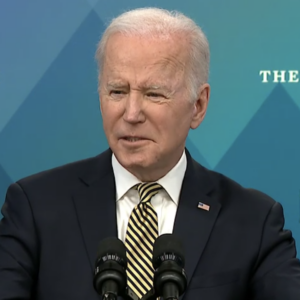Presidential approval ratings, while certainly dependent on outside factors and the realities of the political climate, are not totally impossible to predict.
Milestones that occur on a regular basis throughout the political year, for instance, typically provide a boost to the president. The State of the Union address reliably boosts approval numbers. The “rally around the flag” effect, which often sparks unity when the nation experiences geopolitical strife, similarly pushes polling numbers north. President George W. Bush’s approval numbers shot from roughly 50 percent to around 90 percent in the wake of the 9/11 terrorist attacks.
History and conventional political wisdom suggest that President Biden’s numbers should have some momentum at the moment, having delivered his State of the Union address and engaged in high-level diplomacy related to Russia’s invasion of Ukraine.
Despite these tailwinds, last week saw Biden’s approval rating dip to its lowest level yet.
The media are flummoxed by this dynamic. Pundits at the Washington Post, CNN and MSNBC assert that Biden isn’t getting credit with voters for the things he’s doing for the country. They point to relatively steady markets and robust job postings as evidence of the strength of our economy. They adopt pollyannaish tones about high gas prices and seem unconcerned about inflation. They insist that despite the abysmal approval numbers, voters love the policies the Biden administration is pushing.
Pardon me for my skepticism, but one can’t help but suspect that the prior president wouldn’t have received so much credit for such poor polling numbers. Many in the media are eager to write off the current administration’s poor polling as a symptom of an uninformed electorate. If only people were more thoughtful, they seem to assert, Biden would be riding historical highs instead of weathering shocking lows.
This predilection is just the latest signal of growing disconnect between the political pundit class and the rank-and-file voter.
Occam’s razor — a principle that states that one should not make more assumptions than the minimum needed — suggests that the simplest answer is typically the best answer.
Rather than subjecting themselves to endless contortions in an effort to understand poor polling, perhaps the media should take Occam’s razor to heart: the president’s polling numbers are bad because a majority of voters disapprove the steps his administration is taking, and they feel that the country is heading in the wrong direction.
There. Was that so hard?
There are plenty of signals that those in power don’t share the media’s skepticism about the polling as midterm elections approach. Politicians and officials across the party’s ideological spectrum — from the far-left to the center-left — appear more than a little concerned about the way these polling numbers will translate to the ballot box in November. Many fear it may already be too late to avert an “electoral tsunami” this fall.
There is no secret remedy or silver bullet that will address the Democrats’ fears. But a realistic assessment of the root of the problem certainly wouldn’t hurt. The fact of the matter is that by continually playing to the “elite” in the media and talking-head class, the Democratic Party has further alienated a growing majority of voters whose priorities simply don’t align with those espoused on TV.
These voters spoke up last November when they put Republicans like Virginia governor Glenn Youngkin in power. They speak up every day in polling that shows growing support for generic Republican candidates at the federal level. And without an exceedingly surprising reversal of circumstances in the coming weeks and months, they’re likely to speak up in even greater numbers during the midterm elections.
Odds are, the pundits will likely watch in shock yet again as election returns come in. They’ll wonder why purple states are turning red and blue states are turning purple.
The answer isn’t as complicated as they might like to think. Poor policy leads to poor polling, and we can look no further than last week’s numbers for confirmation of this simple fact.

